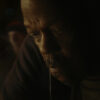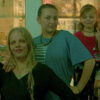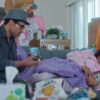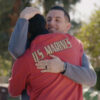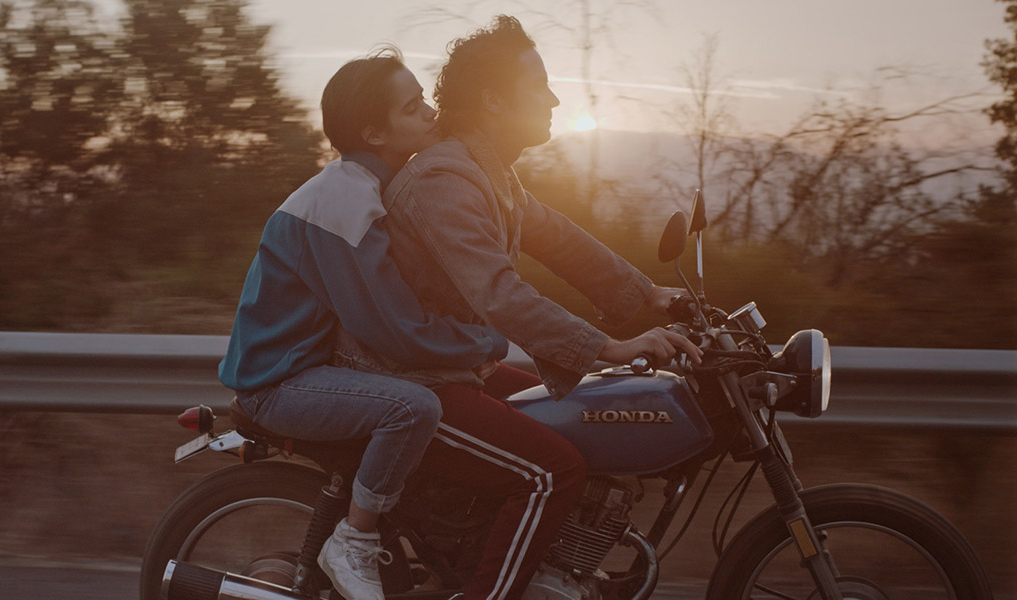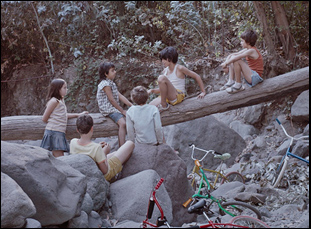Everywhere you look in Dominga Sotomayor’s “Too Late to Die Young,” there’s work being done in the rural part of Chile just removed from Santiago where the writer/director sets up her camera. Men can be seen sanding wood or clearing brush while women scrub clothes in the nearby stream, all in preparation for construction of an artist commune away from the bustle of the big cities during the early 1990s when military occupation over the country gave way to democracy. But as far as Sotomayor’s drama’s concerned, the most radical development seems to be happening within a young woman named Sofia (Demian Hernández). Wandering around the village quite physically taking shape around her, Sofia cautiously opens herself up to taking it all, a sense of discovery that the filmmaker conveys so acutely that she’s found no matter where in the world she’s shown her arresting third feature since its premiere in Locarno, followed by bows at Toronto, New York, London and at AFI Fest in Los Angeles, it’s been felt deeply and specifically by audiences.
“Even though films usually come from very intimate spaces or very personal issues, they’re universal and film doesn’t need to be related to a territory or a specific time,” says Sotomayor. “Cinema is the least nationalistic thing we can have and that’s beautiful.”
The echo of Mazzy Star’s “Fade Into You” wafting through the air as New Year’s approaches only amplifies all the borders that are beginning to crumble in “Too Late to Die Young” as the 16-year-old Sofia informs her friends that soon she’ll be moving in with her mother in the city, leaving behind her father (Andrés Aliaga) and her childhood friend Lucas (Antar Machado), whose long been interested in her romantically. Sotomayor and cinematographer Inti Briones brilliantly use an often-static camera to explore the distance Sofia is putting between herself and the rest of the world as it starts to collapse and although Sofia can usually be seen as still herself, her restlessness provides all the energy that’s needed in a place without any other source of electricity. It’s a film that’s easy to lose yourself in as Sofia begins to find herself and recently Sotomayor was gracious enough to speak about how she drew inspiration from her own upbringing in a community like the one her main character inhabits, creating her own path to making films and how her actors’ evolution in real life carried over to the screen and vice versa.
There are some autobiographical elements in the film because I actually grew up in a community that is not exactly as it’s in the film, but [moved] to a place without electricity or phones when I was four years old and lived there for 20 years. Democracy was just arriving to Chile in the ‘90s and my parents and some friends decided to buy land that was cheap at the time, so they moved to this place and built their own houses. At the beginning, there was no electricity or phones and then in a year, the place was getting more modern and more normal and the city [around it] was getting bigger. So I grew up in this contradiction, having a more traditional family in the city and going to a normal school and [living in this village].
The starting point of my films are always images that kind of invade me, so I was sure this would be my second feature after my first. [laughs] It was like a collection of my childhood, my teenage years, and things of my brothers and sisters and people that I know, and even though it seems very autobiographical, there’s a lot of fiction in it and it is the place and this kind of life that really marked me. I really wanted to make a film that is on one side, a coming-of-age of these kids, going from childhood to teenage years to [being an] adult, these early evolutions, but at the same time, for me it’s a political film because at that time in Chile, it was growing up in a turbulent time with massive changes and for me, this transformation of the country is contained in this little world with this illusion of starting again.
You’ve said before you wanted to approach this differently than your previous feature. Why was that necessary?
I feel like I’m repeating myself all the time, doing the same film in a way since my short films, but also I wanted to go against my own rules. It’s what motivates me – to change. And I wanted a challenge of trying to make a [film from a] collective [point of view]. This is why I didn’t want to spend all the time with one character, but I wanted to jump into all these little stories. The first film I made, I wanted [the perspective] to be related to the subject, so it was about these two kids sitting in the backseat of a car – very formal, but [for “Too Late to Die Young,”] I was thinking I cannot portray the community like this in a traditional way. All the digressions and how there are no borders in the film is related to this image I had of there being no limitation between the interior and the exterior. There is no interior or exterior in this childhood. There were no walls. There was not a clear separation between nature and humanity, feminine/masculine, kids or adults, so this was something that I wanted to explore.
[Visually] I was always working with a lot of personal rules [before]. For instance, it’s really clear [in my first feature] that everything is around the car with these specific shots, and here, there are fixed shots and very general shots, but also some more things we decide [in the midst of filming] like choreography with the camera. One rule was I wanted to be in this space as with the characters and the space will be dramatic I hope as their feelings. I also knew I didn’t want a film that looks like a very well-directed script. I wanted to make something alive and in a sense, casting was very important, so it was a mix of things really written and also trying to be open to what spontaneously was happening while we were shooting.Is it true your mother casts your films? Does that mean you know everybody on camera? Are they all connected to you in some way?
Yeah, totally. It was a very familiar thing. Even though this is my biggest film up to now, I didn’t change my way of working, and my mother lives in this community that now is much bigger as before. I worked with her because I trust her a lot and also because she could go to houses directly or to the people that we know or friends with kids. And I decided [from the beginning] to work with kids without any experience, so we were casting kids from the actual community, and that was a good idea because some of them are friends [with each other in real life]. But it was very challenging to have all these kids because there are a lot better [onscreen], and also some adult [amateurs] that are mixed in with famous actors from Chile – it was a big challenge to make them connect. For me, directing is to have a relationship with people [in the film] and I have a very close relationship with all of them, even now. And when I make films with kids, they become part of my family.
What sold you on Demian to play Sofia?
[In general] I was looking for actors for their age or they’ve lived a lot and you can feel that in a way they have lost some illusions early. It was very interesting because in the script, I was imagining another person, but when I met her, I found her very complex and you cannot tell if she was young or old and it was a genderless feeling that I felt attracted to – I don’t think you can create complexity in a character, but you can capture beautiful things in people in a film, so she was amazing. I could feel she was in a process of transition from something to something else and that was interesting because I was also playing [with these ideas] between interior and exterior, male/feminine and I liked these intermediate states.After shooting, Demian actually started this transitioning process of becoming a boy. I didn’t know before and I think he didn’t by the time we were shooting, but it was very special because all this complexity that was happening to her I could feel that before the film. For Antar, the other kid who plays Lucas, he lost his father just before shooting, and he told me this film is very important for me to be able to be a part of this process, so everybody was in turmoil and I hope the film helps portray it.
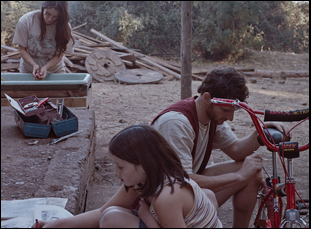
Not much, but we did this workshop with the kids, like a weekend with the teenagers and a weekend with the youngest [children]. Some of them met already before – for instance Lucas’ friends in the film are all [real] friends [of his], but we didn’t do any rehearsals. The youngest became very close friends and now they’re still friends and they go to each other’s houses. I think we pushed to create a real new community of people and [going into production, I saw] this as a big challenge, but now it’s one of the things that I’m happiest about – I really wanted to have a good atmosphere during shooting and then try to just capture it with the camera. It was real that there was something nice [in the air] and we got people that really believed in the process rather than just the results. For me, it was important that this process will be important for each of the people working on the film, [especially] the kids.
You mentioned the community grew bigger since the time you lived there and this feels small and intimate. Did you film in the same location as it actually happened or somewhere else?
Yeah, I probably started writing this film when I was 27 and I came back to live in the community in a little house by myself. One of the motivations was [preserving] this nostalgia of a place that I’ll never be able to come back to after all this transformation I’ve seen. And when we decided to look for locations, I decided to have this limitation of shooting in the same place even though it’s really different now – it was very complex because there’s 400 houses now, but because this is close to the mountains, we were going up to find more open land to shoot. Probably that’s why you are lost in the place. There are no connections because we jump from one place to another.
It gives the film a good quality. I also wanted to ask about using Mazzy Star’s “Fade Into You” – it gives both such a specific feeling and sense of time. Did it have special meaning for you?
Yeah, the music was very important to me and that song in particular I had fight to have it. Of course, [you hear it] and you drive directly to that feeling of falling in love at 15 years old, but it’s also universal and everyone can relate with it. It was a period in Chile where we had all this political music in Spanish from the old generation of the parents and the arrival of Michael Jackson, so it was really eclectic. And I thought of each character, connecting the music with their emotional status. [So I’d ask] what would Sofia listen to? What would [the young girl] Clara like? What would Lucas like? It’s a very musical film and I did some research to get into the right music for each character.
And they all play instruments. Did they know how to play before shooting?
Yeah, in casting, we’d meet and we’d play music for a weekend. I invited little group of kids and teenagers to my mother’s house to a studio we had and we were doing songs. Then I decided who will be the main characters and then the other ones who will be secondary [characters] or the friends. But they all played. They were very talented.
Something else I should ask because it’s our first time talking – if you grew up without electricity, how did you become interested in filmmaking?
My films come more from my life than from cinema. I started watching Kiarostami and Antonioni, Cassavetes, people that inspired me around 16, 17, so I didn’t have electricity at the beginning, but then I did, and I don’t know. Everything is so mysterious. My mother was the main actress on a soap opera, so even though I was living in this community and my friends [at school] were seeing my mother on the TV, I didn’t have the TV to watch her. [laughs] But my huge influences come from painting and theater, and I was lucky to find cinema because it was like an accident also to connect many things that I like. And I think all my films have to do with this illusion of not forgetting. I have a very bad memory and always the starting point has to do with capturing something that is kind of blurry for me. This film was like capturing something that I was forgetting and that I wanted to remember.
“Too Late to Die Young” opens in New York on May 31st at the Film Society of Lincoln Center and on June 7th in Los Angeles at the Laemmle Music Hall.
